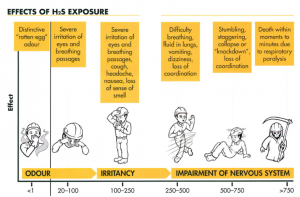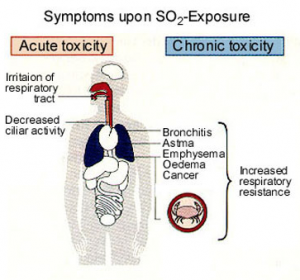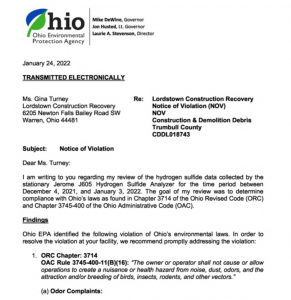Lafarge’s Lordstown Demolition Landfill May Shut Down Soon

H2S's odor can be detected at 8 parts per billion. Chronic exposure can lead to a wide variety of health problems. Children and people with asthma and heart conditions are particularly vulnerable. Acute exposure to H2S can cause paralysis and death. Illustration in ppm
On-going Compliance and Toxic Gas Problems Push Closure Decision as Competitor asks Ohio EPA for Massive Tonnage Increase
The 130 acre Lordstown Landfill began operations in 2004 and created several complicated environmental issues. During the preparatory excavation, Lafarge deeply over-excavated the initial waste cells. The excavation exposed multiple groundwater tables which poured 30 million gallons a year into the waste from the base and sides of the landfill. Lafarge management never reported the perpetual problem.
During an Ohio EPA inspection in 2015, Lafarge was caught pumping 100,000 gallons a day of water from under the landfill into a pond. The ammonia-contaminated water discharged into a tributary of Duck Creek. This, in part, led to a consent order in 2016 which included 31 orders and a $2.8 million dollar fine which was reduced over 90% to $270,000. Unfortunately, the groundwater intrusion is irrevocable and can only be controlled by an intercepting pump system which must be operated indefinitely.
95% of the C&D waste which Lafarge receives originates from outside Ohio and is railed in by CSX via New York. C&D (which 90% is demolition) usually includes asbestos insulation, lead from paint and plumbing fixtures, arsenic from treated lumber, formaldehyde in household paneling, mercury in switches and thermostats and mold from drywall. 95% of the demolished buildings pre-date the EPA by half a century.
Also, there are very few regulations which require obsolescent structures to be cleaned out before demolition — so paints, chemicals, waste oils, pesticides, electronics, solvents and lab wastes from debilitated garages, barns, factories, medical facilities and homes are included. Moreover, garbage and other more expensive wastes can be mixed into the outbound material.
Consequently, C&D creates a wide range of poisonous gases as it decomposes in a landfill. A partial list of toxic gases includes hydrogen sulfide, carbon disulfide, carbonyl sulfide, n-propyl mercaptan, thiophene and diethyl sulfide. Several of these gases smell like rotten eggs and several can enter your body through the skin. The putrid smell led to hundreds of odor and illness complaints by Lafarge’s neighbors through the past 17 years.
More details on the nature of Lordtown's toxic gas emerged in 2019 after dozens of shallow landfill samples were analyzed by an independent laboratory. While hydrogen sulfide’s (H2S) rotten-egg odor can be detected by most people at 10 parts per billion (ppb), Lordstown's in-situ hydrogen sulfide gas concentrations reach a staggering 39,000,000 ppb with carbon disulfide at 90,000 ppb.
For reference, a recent Supreme Court decision in England on a case, filed by a citizen for her dying child born with lung disease, set a limit for the perpetrating C&D landfill at one (1) ppb of H2S.
For 15 years Lafarge downplayed the odor issue and never installed a toxic gas control or safety system. The Ohio EPA demanded one through a second consent order in October 2019.
Lafarge installed a low-budget gas-control system in 2020; it completely failed to stop both the gas emissions and complaints. Components of the system were destroyed by sulfuric acid created by landfill moisture reacting with the hyper-concentrated hydrogen sulfide. Massive leaks in the system exposed workers to the toxic gases; multiple people were sickened and an employee was hospitalized.
Lordstown has violated the Ohio EPA 2016 consent order’s 20 ppb level for off-site H2S more than 1,000 times and nearly 100 times in the first months of 2022.
On May 10, 2022, the Ohio EPA authorized Lafarge to install a rented landfill gas burner, without an air permit, to further study the landfill's gaseous toxins. It will produce SO2, a priority pollutant, which causes its own health problems.
Lafarge is currently operating without a license. The Trumbull County Health Department tabled the license decision in December 2021. License application documents indicate Lordstown has approximately eight years of remaining airspace and only few waste cells left for construction.
Personnel indicate the overwhelming environmental management problems may force Lafarge to close the site. Upon closure, numerous long-term controls must be implemented per EPA regulations and consent orders. Lafarge must seal and maintain the landfill's leaking clay cap, control the stormwater, pump and monitor the groundwater, control the toxic gas, monitor the surrounding air quality and maintain millions of dollars for post-closure funding for a minimum 25 years.
A 34-page verified complaint regarding Lordstown’s leaking clay cap was submitted to the Ohio EPA in July 2022. A verified complaint filed in June 2021 led to 14 different land and water violations in October 2021.
Sunny Farms Landfill, located near Fostoria in western Ohio, is a competitor of Lafarge’s landfill. Sunny Farms also rails 97% of its waste from the East Coast through CSX. Sunny Farms also has a long history of choking its neighbors with H2S and now emits approximately 3,000 tons a year of sulfur dioxide from burning landfill gas.
In apparent anticipation of Lordstown’s early closure, Sunny Farms has asked the Ohio EPA to increase their waste allowance by 4,500 tons per day — which equates closely to Lordstown’s average daily waste receipts. Ohio EPA's approval would increase Sunny Farms' intake to 12,000 tons a day making it one of the largest landfills in the multi-state area. The volume is equivalent to 1,000 curbside garbage trucks every day. Sunny Farms is also asking to operate 24 hours/day.
Upon learning of the massive out-of-state waste increase request, Lori Poignon, one leader of a large group opposing the Sunny Farms Landfill stated “If they have too many problems with 4500 tons...what do you think is going to happen here with 12,000 tons? …The C&D is out of control”
Based on the habitually poor performance of LafargeHolcim’s management team, closing the Lordstown Landfill may be in everyone’s best interest — except, of course — for those living near Fostoria, Ohio.
Markus Aurelius
citizensagainstlordstownlandfill.org
+1 330-715-6634
email us here
Visit us on social media:
Facebook
A man who almost died from H2S — Victim Interview. Victim's experience is a near bullseye for an acute outdoor exposure on a landfill; but not chronic effects


